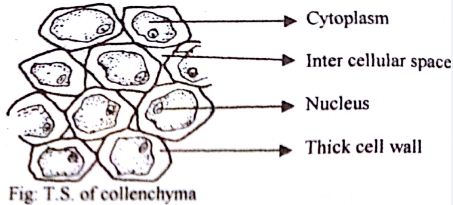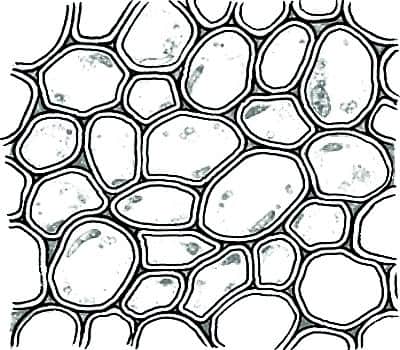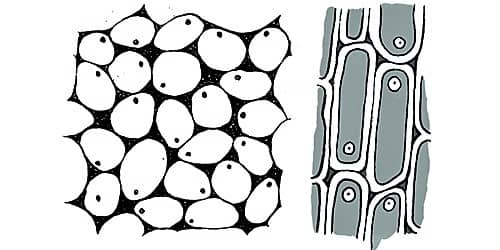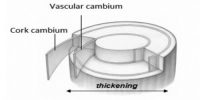Collenchyma cells are elongated cells with unevenly wide cell walls that give sustain and formation. They are mostly mechanical tissue and provide mechanical potency and flexibility to the mounting stems. Their wide cell walls are poised off the compounds cellulose and pectin. As a result, the stems can place bending or swaying by wind or passing animals. These cells are often found under the epidermis or the external layer of cells in young stems and in leaf veins. Collenchyma is also the supporting tissue of the leaves.
Collenchyma Tissue Position: It is generally present in the-
- Sub-epidermal regions of dicot stem.
- Petioles
- Midribs
- Pedicels.

Structure:
- Consists of living cells and the Cell wall is thick
- Usually, the cells are polygonal or round in shape. Intercellular space is usually absent.
- Collenchyma cells give automatic stringency to the rising plant organs. Living mechanical tissue specially modified for sustaining rising organs. It provides mechanical potency to the petiole, leaves, and stem of immature dicot plants.
- Prevents meandering and contravention of stems by wind due to its tensile potency. It allows for increase and elongation of plant organs. It permits the growth and elongation of plant parts.
- Some possess chloroplast and carry out photosynthesis. Photosynthesis takes place in the chloroplast containing Collenchyma cells. Collenchyma when containing chlorophyll performs the utility of photosynthesis.
- Gives elasticity to plant organs throughout their increase. Due to the occurrence of collenchyma cells, the plant parts or organs become stretchy and shows smoothness. It confers elasticity to different parts of the plant like petiole and stem, allowing for simple meandering without fracture.
- Collenchyma present in leaves also prevents them from tearing. The living cells of collenchyma store food.

Function:
The thickened walls of the collenchyma cells facilitate them to give supplementary sustain to the areas wherever they are found. Protein and cellulose are also present. Major pit fields can be illustrious in the walls. Most prominently, collenchyma cells give out increasing parts of the plant, such as shoots and leaves, both by as long as maintain and by substantial in empty spaces.
- If it contains chlorophyll, it may produce food. It provides mechanical support to the growth regions of plants.
- Collenchyma contains living protoplast. Chloroplastids might also be there in some cells. The cells might also surround tannins.
- The cellulose microfibrils are both oriented crosswise or alternately transverse and longitudinal. The composition of these irregular layers varies.
- One layer is wealthy in cellulose and deprived in pectin; the alternate layer is pectin-rich and cellulose-poor.
- Lignified lamellae might also be deposited on the wall. Thus the pesto-cellulosic wall of collenchyma may become clarified.














